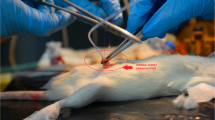Abstract
An experimental study was planned to evaluate and compare the effects of orchidopexy and orchidectomy on the testes of rats subjected to unilateral abdominal testis with vas deferens obstruction. Four groups were established. Rats in the control group underwent a sham procedure. While the testis was maintained in the abdomen with the vas deferens ligated for 8 weeks in group 2, rats in groups 3 and 4 underwent orchidopexy or orchidectomy after 4 weeks. Remaining testes were harvested at the end of the 8-week period. Testis and body weights were obtained during harvest. Samples were evaluated through DNA flow cytometry, and percentages of haploid cells were determined. Groups were compared through unpaired t-test, and p-values less than 0.05 were considered significant. All three treatments had decreased testis weight over body weight values of ipsilateral testes. Ipsilateral orchidectomy increased the value among contralateral testes. However, none of the groups had a contralateral testicular value less than the sham-operated group. All three treatments decreased the percentage of haploid cells among ipsilateral testes, but only an abdominal testis was associated with a decrease in the percentage of haploid cells among contralateral testes. Maintaining a testis with an obstructed vas deferens in the abdomen for 8 weeks damages both ipsilateral and contralateral testes. Orchidopexy, while showing amelioration of the ipsilateral testis, spares the contralateral testis as well as orchidectomy. Orchidopexy for an undescended testis with vas deferens obstruction is a rational approach.
Similar content being viewed by others
References
Andıran F, Okur HD, Kılınç A, Kılınç G, Tanyel FC (2000) Do experimentally induced ipsilateral testicular torsion, vas deferens obstruction, intraabdominal testis or venous obstruction damage the contralateral testis through a common mechanism? BJU Int 85:330–335
Antypas S, Sofikitis N, Rodriguez F, Zavos PM, Miyagawa I (1994) Bilateral effect of unilateral vasectomy on testicular testosterone biosynthesis. J Pediatr Surg 29:828–831
Chan LS, Lipshultz LI, Schwartzendruber D (1984) Deoxyribonucleic acid flow cytometry: a new modality for quantitative analysis of testicular biopsies. Fertil Steril 41:485–487
Fonkalsrud EW (1987) Testicular undescent and torsion. Pediatr Clin North Am 34:1305–1317
Gill B, Kogan S, Starr S, Reda E, Levitt S (1989) Significance of epididymal and ductal anomalies associated with testicular maldescent. J Urol 142:556–558
Hashimoto O (1984) Flow cytometric analysis of DNA in testicular cells of Wistar rats. Nishinihon J Urol 46:533–539
Hellstrom WJ, Tesluk H, Deitch AD, de Vere White RW (1990) Comparison of flow cytometry to routine testicular biopsy in male infertility. Urology 35:321–326
Hittmair A, Rogatsch H, Offner F, Feichtinger H, Ofner D, Mikuz G (1992) Deoxyribonucleic acid flow cytometry and semi-quantitative histology of spermatogenesis: a comparative study. Fertil Steril 58:1040–1045
Hurwitz RS, Kaptein JS (2001) How well does contralateral testis hypertrophy predict the absence of the nonpalpable testis? J Urol 165:588–592
Karnak İ, Gedikoğlu G, Tanyel FC, Büyükpamukçu N, Hiçsönmez A (1996) The effects of chemical sympathectomy on contralateral testicular histology, fertility and fecundity in unilateral abdominal testis. Br J Urol 77:580–584
Kawai S (1985) DNA flow cytometric evaluation of spermatogenesis. Acta Urol Jpn 31:147–151
Matsuda T, Horii Y, Yoshida O (1992) Unilateral obstruction of vas deferens caused by childhood inguinal herniorrhaphy in male infertility patients. Fertil Steril 58:609–613
Mollaeian M, Mehrabi V, Elahi B (1994) Significance of epididymal and ductal anomalies associated with undescended testis: study in 652 cases. Urology 43:857–860
Oğuzkurt P, Okur HD, Tanyel FC, Büyükpamukçu N, Hiçsönmez A (1998) The effects of vasodilatation and chemical sympathectomy on spermatogenesis after unilateral testicular torsion: a flow cytometric DNA analyses. Br J Urol 82:104–108
Parkhouse H, Hendry WF (1991) Vasal injuries during childhood and their effects on subsequent fertility. Br J Urol 67:91–95
Patkowski D, Czernik J, Jeleń M (1992) The natural course of cryptorchidism in rats and the efficacy of orchidopexy or orchidectomy in its treatment before and after puberty. J Pediatr Surg 27:870–873
Quinn FM, Crockard AD, Brown S (1991) Reversal of degenerative changes in the scrotal testis after orchidopexy in experimental unilateral cryptorchidism. J Pediatr Surg 26:451–454
Salman AB, Okur HD, Tanyel FC (1998) DNA flow cytometry reveals depressed spermatogenetic activity in the contralateral testis within 24 h of ipsilateral spermatic cord torsion independently of the presence of the testis and epididymis. Eur Urol 34:377–381
Türken A, Okur HD, Gedikoğlu G, Tanyel FC (2001) Effects of abdominal location and epididymal or vasal obstructions either individually or in association on ipsilateral and contralateral testes. Eur Urol 39:449–454
Author information
Authors and Affiliations
Corresponding author
Rights and permissions
About this article
Cite this article
Otçu, S., Karnak, İ., Okur, H.D. et al. The effects of orchidopexy and orchidectomy on testes of rats subjected to ipsilateral abdominal testis with vas deferens obstruction. Ped Surgery Int 20, 614–617 (2004). https://doi.org/10.1007/s00383-004-1242-3
Received:
Accepted:
Published:
Issue Date:
DOI: https://doi.org/10.1007/s00383-004-1242-3



